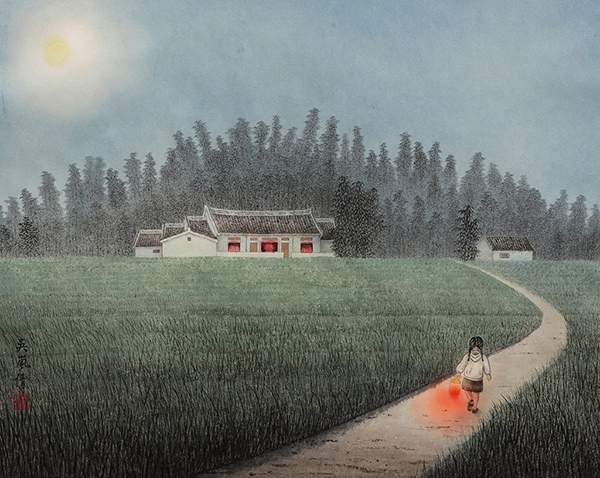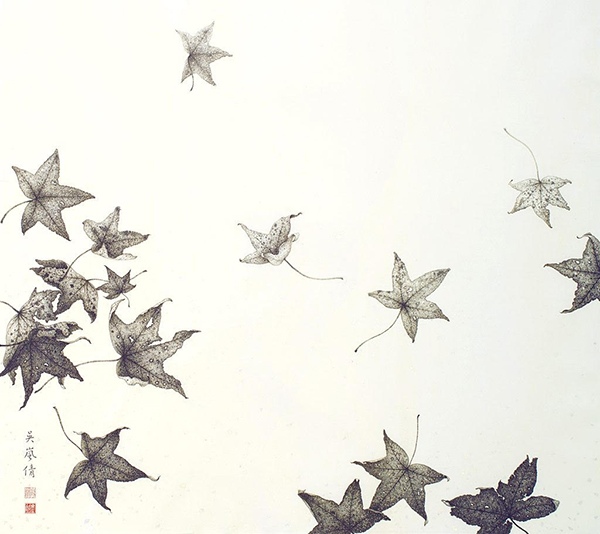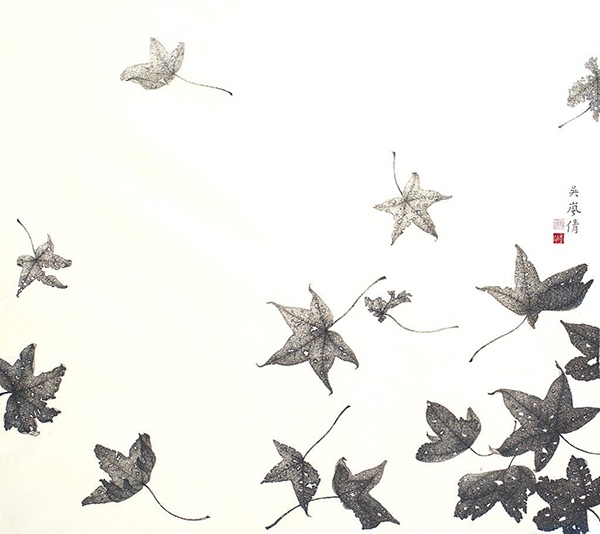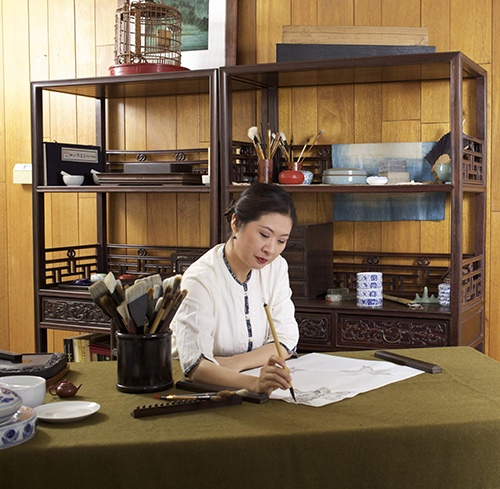
Precious Light – Interview with Contemporary Ink Artist Ms. Wu Lan-Chiann
Ms. Wu Lan-Chiann’s ink paintings are dreamlike, profound in artistic conception, gentle yet tenacious, subtle yet strongly emotional, and poetic. They exhibit the essence of Chinese ink painting and also incorporate the techniques of Western three-dimensional painting skills. Ms. Wu’s paintings have a style all their own, depicting a pure and enchanting world in opposition to the secular world. Her paintings are full of imagery that evokes the ideals buried in people’s hearts. Ms. Wu is an acclaimed contemporary ink artist. As a result, her artworks are highly collectible by art lovers and by select museums from all over the world.
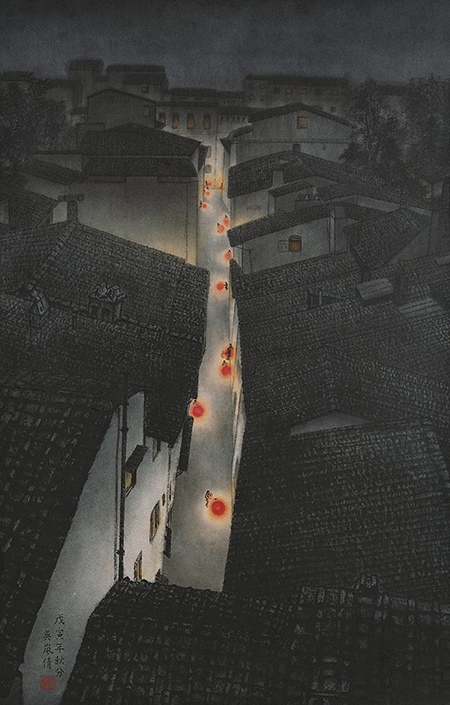
Ms. Wu Lan-Chiann was born in Taiwan and studied at the Chinese Culture University in Taipei, then furthered her study at New York University in the United States. After being surrounded by Chinese and Western cultures, having mastered skills from each, her paintings show a profound reflection on the life experience by the creator: she listens attentively to her heart and carefully observes the world; her work is a contemplation on how human beings go through the same journeys whether from the East or West. We are all born, get old, sick, and eventually die; it is inevitable. However, human resilience, wisdom, and love help transcend our secular ties and give hope to create a harmonious world together. Ms. Wu Lan-Chiann’s Precious Light series represents her grasp on life, her empathy, coupled with a dose of childhood nostalgia, and her vision for the world.
We are honored to be able to interview Ms. Wu. Her words of wisdom and timeless paintings are deeply rooted in life and people’s hearts. I hope the following interview will also be a beacon for you.
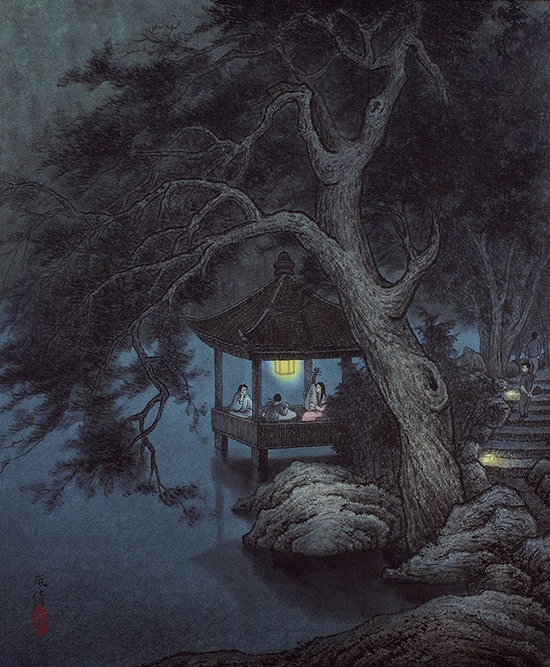
Q: Your ink paintings have achieved high acclaim both in the East and the West. Please share with us your background and the artistic training that led you to become such a distinguished contemporary ink painting artist.
A: From as early as I can remember, I knew that I wanted to be an artist. Around age nine, my world opened up when my parents gave me a set of international museum catalogs. The images just took my breath away, and I became determined to find the best teachers we could afford. At twelve, I entered a watercolor competition, first at the city level, then state, and finally, I won second place at the national level. I received an award from the Mayor of Taipei, and it earned me a spot at the fine arts program of Taipei City Jinhua Junior High School. I sacrificed a lot for being enrolled, as each day I walked twenty minutes to take a one-hour train, and then a half-hour bus to reach the school. Four hours each day, I was that determined!
I studied ink painting at the Chinese Culture University in Taipei. While many people encouraged me to pursue conceptual art; I was drawn to traditional ink painting. I learned through copying masterpieces from the collection at the National Palace Museum in Taipei. Besides learning the techniques, the idea was that you absorbed with your soul – which I certainly did! I had several excellent teachers, most notably Au Ho-nien, a living master of the Lingnan school, an important artist movement in modern Chinese ink painting.
At NYU, I was exposed to Western art and explored oil and acrylic painting. I studied with Arnold Mesches (1923-2016), who was infectiously passionate about painting. Studying art in New York City rounded out my artistic formation and gave me the opportunity to further develop Eastern and Western modes of expression. After my graduation, I returned to ink painting and began to develop a more personal style. Ink and paper allow me to express myself to the fullest extent possible and give me the ability to imbue my work with deep meaning. I see my paintings similar to poetry that often has profound meaning beyond the beauty of the words.
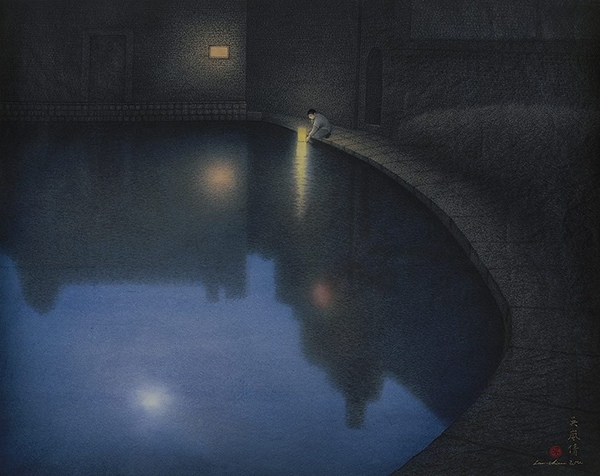
Q: Your Precious Light series seems to reflect a world suffused with dreams and deep memory. Please tell us what prompted you to start this series and share with us some stories behind it.
A: I started the Precious Light series because I was interested in expressing universal themes and values in my work, which I transform to envisioned realities that link past and present and bridge different cultures. We all confront questions such as, why are we here and what is our purpose in life? The depth of human intellect and emotion is an inexhaustible resource, for example, the innate strength that we possess to overcome personal or collective challenges deeply fascinates me.
Everyone experiences their life in a personal way, however, we are sometimes confronted with difficult moments, such as, for example, the passing of a loved one. This is not different for me; however, I confront my struggles through paintings that make conscious connections between emotion and place. In my series of Precious Light paintings, the recurring use of light, or sometimes only glimmers of light, are metaphors for human resilience: the love, hope, and strength that we carry within.
My paintings Reflections of the Past (1999) and Precious Light (2012) are good examples. Resilience is a central theme in these paintings. It is the innate strength that we all share, which helps us endure difficult phases in our lives. Reflections of the Past was inspired by the Japanese summer festival of remembrance, called O-Bon. O-Bon is an annual reminder of the importance of family ties, of respect for those who have gone before us, and of the brevity and preciousness of our lives together. Japanese people welcome home the souls of deceased family members by floating paper lanterns on the water. I am keenly aware that everyone carries within his or her soul memories of passed loved ones like precious, glowing lights; Precious Light is an example of this. While the festival of O-Bon is a collective tribute to those who have passed away, the lonely little boy in Precious Light expresses my belief that each individual deals with his or her memories in a very personal way, which in this painting is particularly poignant.
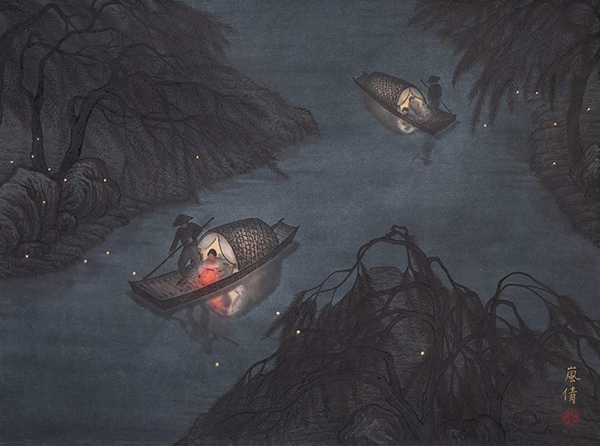
Q: You are so talented at combining the traditional Chinese ink style with contemporary mediums and techniques. How do you employ both techniques at one time and make them compliment each other?
A: Six Dynasties landscape painter and philosopher Zong Bing (375–443) said: “I am here surrounded by creation, my eyes see the things that surround me, that’s why I paint the shapes captured in my heart, that’s why I paint the colors I feel in my heart.” For me, the essence of Chinese ink painting remains exactly as the ancient masters described it: not an imitation of nature but rather nature represented through the soul of the artist. In addition, the quality of brushstrokes is tremendously important in Chinese ink painting. It has to be strong and controlled, yet dynamic, fluid, and delicate. Painting on mulberry paper with watery ink requires absolute mastery of the medium because mistakes cannot be corrected; errors are unforgiving; the moment a brush touches paper, ink is absorbed and what has been painted cannot be undone. Consequently, in this medium, free expression can only be achieved through mastery of medium and techniques. Only then can you express yourself freely.
As I mentioned before, I have always been fascinated by Western art. That said, my art is undeniably rooted in the ancient Chinese tradition of ink painting. So, in a certain way, I naturally combine Western and Eastern modes of expression into my own authentic style. I also bring Chinese and Western poetry into my paintings and, through my art, I share my view on universal humanistic values that span different cultures, time, and space.
I hope that my paintings are not mere images. I aim to create paintings as layered content that represent universal themes that each and all of us experience in life. Thus conceptually, as well as aesthetically, my work bridges cultures, time, and space.
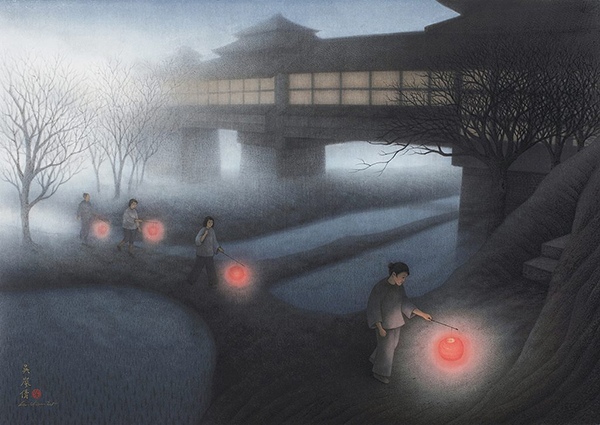
Q: What does art mean to you and what do you attempt to communicate to people through your art?
A: I feel that art speaks a universal language that is understood by people across time and place. My work provides viewers with an opportunity for having a moment of contemplation on life.
Through my paintings, I communicate with people from different cultures, and I utilize art as a means to invite participation that generates dialogue, raises awareness, and cultivates intercultural understanding.
It has always been important to me to reach diverse audiences and show that, upon reflection, we are all One People. Everyone enters this world defenseless and curious, shares the same hopes and fears, acts out of kindness or spite, and goes through the same stages of sorrow and grief. This is the main theme in my art, and I aim for my work to contribute to a broader dialogue about core values and principles that binds us together as one. By blending Eastern and Western modes of expression, painting techniques, aesthetics, and philosophy, I seek to transcend cultural boundaries and create a timeless commentary on humanity.
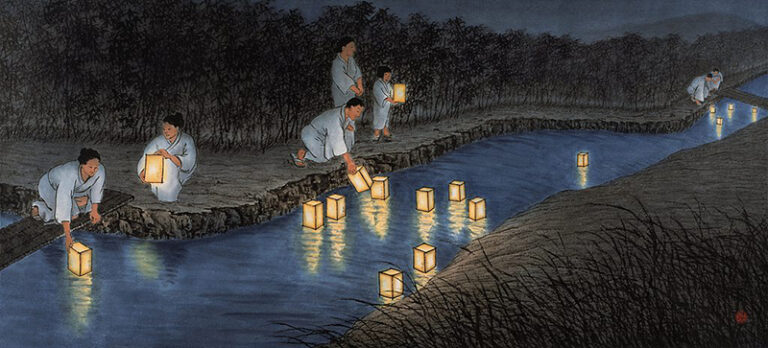
Q: Your Lantern Festival I (1999) painting is absolutely exquisite and utterly enchanting. It seems to reflect a state of mind embodying purity and hope. Please tell us what inspired you to paint it and what symbolic meanings do lanterns have for you.
A: Lantern Festival I (1999) represents the universality of cities’ energies.
I painted Lantern Festival I after my visit to Florence in 1997. I was transformed by the architectural beauty of the city and made several sketches looking down from one of the windows of the Palazzo Vecchio. To express my special feeling for Florence, I wanted to give this painting a mesmerizing quality by creating a night scene. I tested this effect with charcoal and a basic composition before I completed the work. During the creation of this painting, my imagination brought me back to my childhood’s favorite festival in Taiwan. At that particular moment, I realized that no matter which city (East or West) you visit, a city’s energy is universal, and that is what I wanted to express in this painting.
Lantern Festival I also demonstrates my interests in perspective and light and illustrates that I make conscious connections between people and places, across cultures. As I mentioned earlier, the recurring glimmers of light, and as well as the light from the lanterns, are metaphors for human resilience: the love, hope, and strength that we carry within.
Q: Please tell us about your Leaves Series; the theme and the techniques you employed.
A: My experience living in both East and Western societies confirms my belief in our humanity, our core values and principles; they are what binds us together as One People. In recent years, I started creating a new painting series depicting tree leaves in different shapes and states, as metaphors for human life. In my Leaves Series, each leaf has its own lifecycle displaying unique shapes and color intensities, and, during Autumn, each descends on their individual path floating through the air and touching earth in their own way. The leaves represent human beings, and some have a clear direction, but others are hurt and lost. While some lives are peaceful, others are turbulent, all captured in these paintings.
The leaves in my paintings East Wind West Wind (2015) represent human life in both East and West societies, and both share the same core values and principles in the societies, and as well as the same cycle of life rhythm.
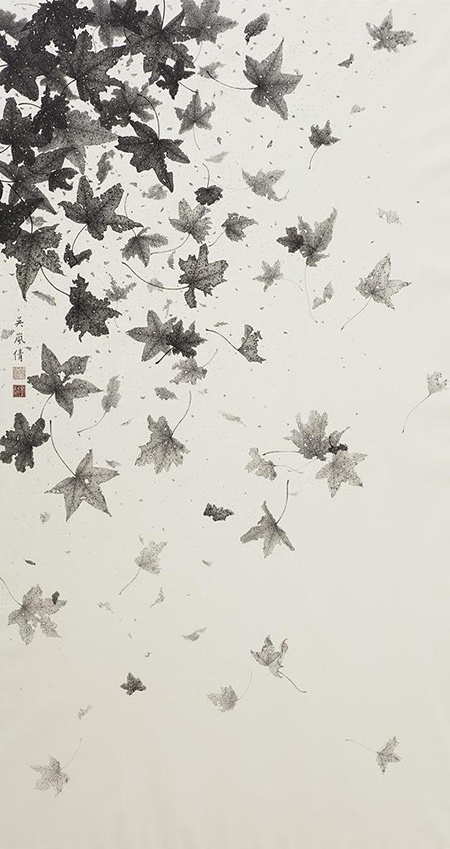
One painting in this series, Before the Storm (2015), was collected by the Nelson-Atkins Museum of Art in 2018, and now looking back, it is bittersweet that I created Before the Storm before the Global Pandemic, and how the whole world experienced the same enormous storm.
My series of leaves paintings was created with ink and metal leaf on hand-made paper. In these works, I wanted to create powerful images showing leaves and dust flying around and up in the air. Sometimes I used ink and color to paint the leaves, and metal flakes for the dust, which added to the energy in the painting.
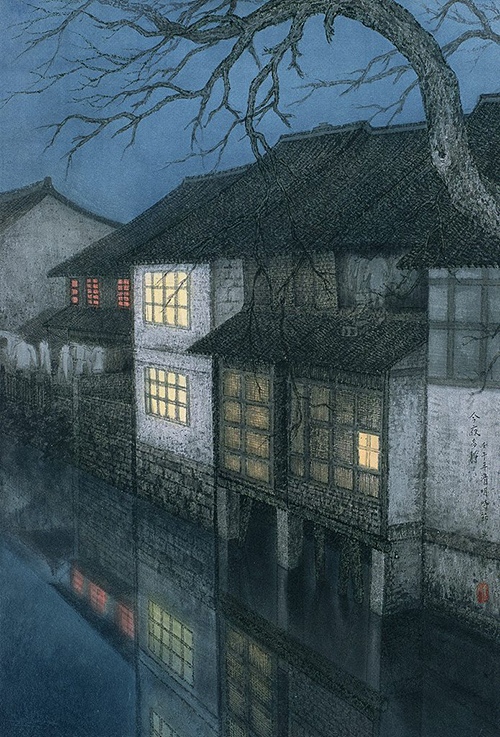
Q: The traditional architecture and houses in Taiwan must be important to you as they appear in many of your paintings. What does that traditional architecture mean to you?
A: I am very close to my grandmother, and she used to bring me to visit her old home, a traditional house in the mountains, when I was a little girl. I have many loving memories of that house, which mean home to me. A good example is my painting Tranquil Night (2002). Tranquil Night is one of my favorite works, which I painted recalling fond memories of my grandmother. Her home was a safe and comforting place where I played in the surrounding fields, and I remember how quiet the night was. This is the feeling I tried capturing in Tranquil Night.
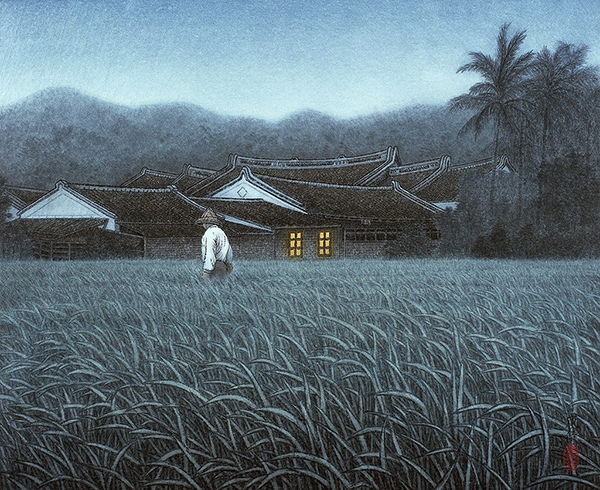
In addition, I am moved by universal humanistic values and principles that cross every society. My painting is often inspired by the work of others who share similar values, for example, in a poem, a story, or a novel. A good example of such inspiration came from Pearl S. Buck’s seminal novel The Good Earth. Published in 1931, the story of struggling farmer Wang Lung is set in China, but it could have been any farm in any country, and toiling workers desperate to make a living is a universal theme. My painting The Good Earth (2004) is a response to the novel. I created an image with a low perspective and an overall composition that is more typical of Western art. The light inside the farm creates a sense of interior warmth and safety: the hope within.
Everyone experiences life in a personal way, we all have ups and downs and difficult moments to overcome. I transform my struggles into art that makes conscious connections between emotion and place. Two of my paintings, House of Souls I and House of Souls II, illustrate this point. I carry within memories of past loved ones like precious, glowing lights set within a traditional building. Most people may feel this as well and, through my work, I provided visual access to this emotion. Our humanity, our core values, and principles, are what bind us together as One People, and this is a motif in my art.
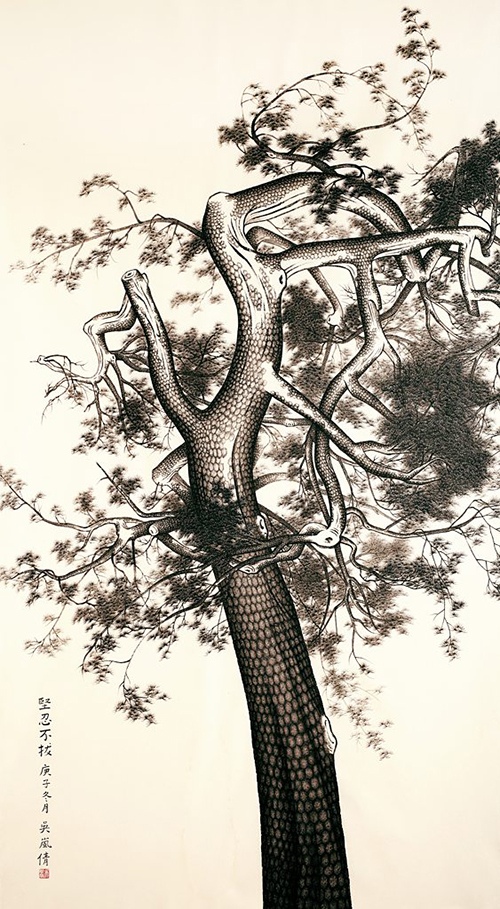
Q: Do you have any projects or exhibitions that you would like to share with our readers?
A: Early this year, I completed a painting that depicted a weathered pine tree entitled Perseverance (2021). A pine tree’s evergreen characteristic has been a symbol of the praised virtue Perseverance in Chinese culture for many centuries. Because no matter how harsh the weather (or life) may be, a pine tree will remain green in every season. I painted Perseverance in response to the global pandemic; people around the world are longing for life to return to normal, and it takes real perseverance to wait for that day. I think that perseverance is an innate human strength that comes out in difficult and challenging times. I hope that this painting brings hope to people’s lives. Now I am embarking on creating a series of paintings based on this particular work.
I am firmly anchored by the belief that art has the power to heal and unite, to challenge and inspire. I strongly believe in expressing universal humanistic values through my work and, my core conviction, that we are One People.
